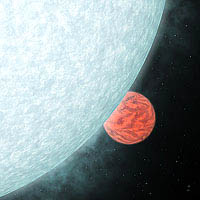"...we are on the verge of finding evidence for other Earth-like planets in the neighborhood of our galaxy. That is really an incredibly profound advance in science."
- Alan Ball, Ph.D., Carnegie Institution

March 25, 2005 Washington, D. C - NASA's Spitzer Space Telescope, launched in August 2003, is the largest infrared telescope ever placed in space to orbit the sun. Now, for the first time, the Spitzer Space Telescope has captured the light and heat from two planets orbiting very distant stars, one 150 light years away and the other 500 light-years. The findings mark the beginning of a new age for planetary science, in which "extrasolar" planets can be directly measured and compared. In order for the Spitzer telescope to see the heat from such distant planets, the telescope must be cooled to near absolute zero (-459 degrees Fahrenheit or -273 degrees Celsius) so that it can observe infrared signals from space without interference from the telescope's own heat. Also, the telescope must be protected from our Sun's heat and the infrared radiation put out by the Earth. To do this, Spitzer carries a solar shield and was launched into a special orbit which places Spitzer far enough away from the Earth to allow the telescope to stay cold without having to carry large amounts of cryogen coolant.
Click here to subscribe and get instant access to read this report.
Click here to check your existing subscription status.
Existing members, login below:
© 1998 - 2024 by Linda Moulton Howe.
All Rights Reserved.

